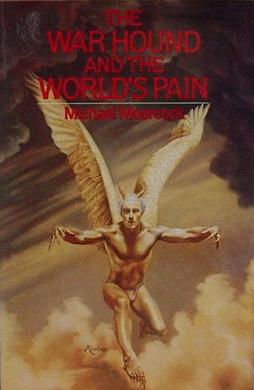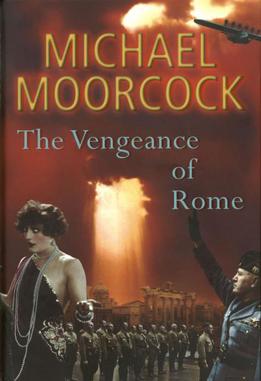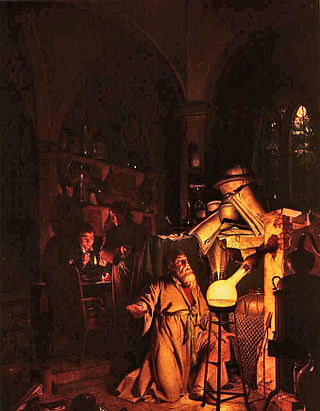
Michael John Moorcock is an English–American writer, particularly of science fiction and fantasy, who has published a number of well-received literary novels as well as comic thrillers, graphic novels and non-fiction. He has worked as an editor and is also a successful musician. He is best known for his novels about the character Elric of Melniboné, which were a seminal influence on the field of fantasy in the 1960s and 1970s.

Elric of Melniboné is a fictional character created by English writer Michael Moorcock and the protagonist of a series of sword and sorcery stories taking place on an alternative Earth. The proper name and title of the character is Elric VIII, 428th Emperor of Melniboné. Later stories by Moorcock marked Elric as a facet of the Eternal Champion.

Sword and sorcery (S&S) or heroic fantasy is a subgenre of fantasy characterized by sword-wielding heroes engaged in exciting and violent adventures. Elements of romance, magic, and the supernatural are also often present. Unlike works of high fantasy, the tales, though dramatic, focus on personal battles rather than world-endangering matters. Sword and sorcery commonly overlaps with heroic fantasy. The genre originated from the early-1930s works of Robert E. Howard. The term "sword and sorcery" was coined by Fritz Leiber in the May 1961 issue of the fantasy fanzine Amra, to describe Howard and the stories that were influenced by his works. In parallel with "sword and sorcery", the term "heroic fantasy" is used, although it is a more loosely defined genre.
The Eternal Champion is a fictional character created by British author Michael Moorcock and is a recurrent feature in many of his speculative fiction works.

The War Hound and the World's Pain is a 1981 fantasy novel by English writer Michael Moorcock, the first of the "von Bek" series of novels.

Fantasy literature is literature set in an imaginary universe, often but not always without any locations, events, or people from the real world. Magic, the supernatural and magical creatures are common in many of these imaginary worlds. Fantasy literature may be directed at both children and adults.

Elements of the supernatural and the fantastic were an element of literature from its beginning. The modern genre is distinguished from tales and folklore which contain fantastic elements, first by the acknowledged fictitious nature of the work, and second by the naming of an author. Works in which the marvels were not necessarily believed, or only half-believed, such as the European romances of chivalry and the tales of the Arabian Nights, slowly evolved into works with such traits. Authors like George MacDonald (1824–1905) created the first explicitly fantastic works.

The Warlord of the Air is a 1971 British alternate history novel written by Michael Moorcock. It concerns the adventures of Oswald Bastable, an Edwardian era soldier stationed in India, and his adventures in an alternate universe, in his own future, wherein the First World War never happened. It is the first part of Moorcock's A Nomad of the Time Streams trilogy and, in its use of speculative technology juxtaposed against an Edwardian setting, it is widely considered to be one of the first steampunk novels. The novel was first published by Ace Books as part of their Ace Science Fiction Specials series.

Mythago Wood is a fantasy novel by British writer Robert Holdstock, published in the United Kingdom in 1984. Mythago Wood is set in Herefordshire, England, in and around a stand of ancient woodland, known as Ryhope Wood. The story involves the internally estranged members of the Huxley family, particularly Stephen Huxley, and his experiences with the enigmatic forest and its magical inhabitants. The conception began as a short story written for the 1979 Milford Writer's Workshop; a novella of the same name appeared in the September 1981 edition of The Magazine of Fantasy & Science Fiction.

The Eternal Champion is a fantasy novel by Michael Moorcock that introduces the hero known as both John Daker and Erekosë. Originally written in the late 1950s, it constitutes the first novel of Moorcock's sprawling Eternal Champion series. The tale was first published in 1962 as a magazine novella Moorcock expanded the novella to novel length for publication in 1970. He revised the text for its 1978 publication. Along with expanding the original story, the novel makes some minor changes to narration and scenes, and also includes references to other short stories by Moorcock. The Eternal Champion is the first in a trilogy of novels known as the Erekosë series. The sequel novels are Phoenix in Obsidian, and The Dragon in the Sword (1987).

The City in the Autumn Stars: Being a Continuation of the Story of the Von Bek Family and Its Association With Lucifer, Prince of Darkness is a science fantasy novel by British author Michael Moorcock. The second book in the Von Bek trilogy, it was published by Grafton in 1986. The story centres on the characters of Manfred von Bek, a descendant of Ulrich von Bek, who is also the protagonist of the previous book in the series and Libussa Cartagena y Mendoza-Chilperic, the Duchess of Crete, along with their journey to the mystical Mittelmarch, and their search for the Holy Grail.

The Laughter of Carthage is a historical fiction novel by English author Michael Moorcock published by Secker & Warburg in 1984. It is the second in the Pyat Quartet tetralogy, preceded by Byzantium Endures and followed by Jerusalem Commands. It was written in tandem, one during the day, and one at night, with the second novel in the Von Bek series, The City in the Autumn Stars.

The Broken Sword is a fantasy novel by American writer Poul Anderson, originally published on 5 November 1954. It was issued in a revised edition by Ballantine Books as the twenty-fourth volume of their Ballantine Adult Fantasy series in January 1971. The original text was returned to print by Gollancz in 2002. The novel is set during the Viking Age and the story contains many references to the Norse mythology.

The Vengeance of Rome is a historical fiction novel by English author Michael Moorcock, published by Jonathan Cape in 2006. It is the fourth and final in the Pyat Quartet tetralogy, preceded by Jerusalem Commands.

Elements of the supernatural and the fantastic were an element of literature from its beginning, though the idea of a distinct genre, in the modern sense, is less than two centuries old.

The Condition of Muzak is a novel by British fantasy and science fiction writer Michael Moorcock, published by Allison & Busby in 1977. It is the final novel of his long-running Jerry Cornelius series. It was first published in its revised form in 1979.

The Cornelius Quartet is the collective name for the Jerry Cornelius novels by Michael Moorcock, although the first one-volume edition was entitled The Cornelius Chronicles. It is composed of The Final Programme, A Cure for Cancer, The English Assassin and The Condition of Muzak. The collection has remained continuously in print for 30 years.
Una Persson is a recurring character in many of Michael Moorcock's 'multiverse' novels. She has also been used as a character in stories by other writers. She was the character Moorcock chose to start a round-robin story in The Guardian.
This is a bibliography of the works of Michael Moorcock.
The multiverse is a series of parallel universes in many of the science fiction and fantasy novels and short stories written by Michael Moorcock. Central to these works is the concept of an Eternal Champion who has potentially multiple identities across multiple dimensions. The multiverse contains a legion of different versions of Earth in various times, histories, and occasionally, sizes. One example is the world in which his Elric Saga takes place. The multiplicity of places in this collection of universes include London, Melniboné, Tanelorn, the Young Kingdoms, and the Realm of Dreams.
















